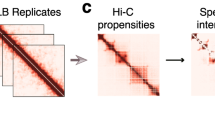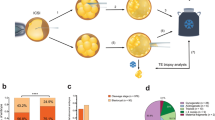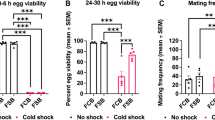Abstract
The viabilities between egg and adult life stages of Drosophila pseudoobscura karyotypes were studied at low, intermediate, and high frequencies. The viabilities of pairs of karyotypes were compared at each frequency and the viabilities of the three karyotypes, at one combination of frequencies. Eggs were counted into vials and samples taken of the adults emerging after viability selection. ST and CH gene arrangements of the third chromosome carrying different amylase alleles were used, and the karyotypes of adult flies were scored by gel electrophoresis. A statistical method related to the loglinear model was developed for estimating viabilities. This method takes account of the additional variability between replicates common in experiments of this kind and allows testing of nested hypotheses about the mechanism of selection. The viabilities of the homokaryotypes relative to the heterokaryotype were significantly higher at the low homokaryotypic frequency than at the higher ones. These viabilities do not show a consistent heterozygote advantage. This pattern of frequency-dependent viabilities will lead to a protected polymorphism for the gene arrangements, even in the absence of heterozygote advantage.
Similar content being viewed by others
Article PDF
References
Anderson, W W. 1969. Selection in experimental populations. I. Lethal genes. Genetics, 62, 653–672.
Anderson, W W, and Brown, C J. 1984. A test for rare male mating advantage with Drosophila pseudoobscura karyotypes. Genetics, 107, 577–589.
Anderson, W W, Levine, L, Olvera, O, Powell, J R, De La Rosa, M E, Salceda, V M, Gaso, M I, and Guzman, J. 1979. Evidence for selection by male mating success in natural populations of Drosophila pseudoobscura. Proc Nat Acad Sci USA, 76, 1519–1523.
Anderson, W W, Oshima, C, Watanabe, T, Dobzhansky, T H, and Pavlovsky, O. 1968. Genetics of natural populations. XXXIX. A test of the possible influence of two insecticides on the chromosomal polymorphism in Drosophila pseudoobscura. Genetics, 58, 423–434.
Anderson, W W, and Watanabe, T K. 1974. Selection by fertility in Drosophila pseudoobscura. Genetics, 77, 559–564.
Anscombe, F J, and Glynn, W J. 1983. Distribution of the kurtosis b2 for normal samples. Biometrika 70, 227–234.
Arnold, J. 1981. Statistics of natural populations. 1: Estimating an allele probability in cryptic fathers with a fixed number of offspring. Biometrics, 37, 495–504.
Arnold, J, and Morrison, M L. 1985. Statistics of natural populations. II: Estimating an allele probability in families descended from cryptic mothers. Genetics 109, 785–798.
Ayala, F J, and Campbell, C A. 1974. Frequency-dependent selection. Annual Rev Ecol Syst, 5, 115–138.
Brier, S S. 1980. Analysis of contingency tables under cluster sampling. Biometrika 67, 591–596.
Bundgaard, J, and Christiansen, F B. 1972. Dynamics of polymorphisms: I. Selection components in an experimental population of Drosophila malanogaster. Genetics, 71, 439–460.
Clark, A G, and Do Ane, W W. 1984. Interactions between the amylase and adipose chromosomal regions of Drosophila melanogaster. Evolution, 38, 957–982.
Clark, A G, and Feldman, M W. 1981. Density-dependent fertility selection in experimental populations of Drosophila melanogaster. Genetics, 98, 849–869.
Clark, B C. 1962. Balanced polymorphism and diversity of sympatric species. In Nichols, D. (ed.) Taxonomy and Geography, Systematics Association Publication No 4.
Clegg, M T, and Allard, R W. 1973. Viability versus fecundity selection in the slender wild oat, Avena barbata L. Science, 181, 667–668.
Cornell, J. 1973. Experiments with mixtures: a review. Tech-nometrics, 15, 437–455.
Cornell, J. 1979. Experiments with mixtures: an update and bibliography. Technometrics, 21, 95–106.
Dawood, M M, and Strickberger, M W. 1969. The effect of larval interaction on viability in Drosophila melanogaster. III. Effects of biotic residues. Genetics, 63, 213–220.
Dobzhansky, T H. 1943. Genetics of natural populations. IX. Temporal changes in the composition of populations of Drosophila pseudoobscura. Genetics, 28, 162–186.
Dobzhansky, T H. 1944. Chromosomal races in Drosophila pseudoobscura and its relatives. In Dobzhansky, Th. and Epling, C. Contributions to the Genetics, Taxonomy, and Ecology of Drosophila Pseudoobscura and Its Relatives, Carnegie Institution of Washington Publication, 554.
Dobzhansky, T H. 1947a. Adaptive changes induced by natural selection in wild populations of Drosophila. Evolution, 1, 1–16.
Dobzhansky, T H. 1947b. Genetics of natural populations. XIV. A response of certain gene arrangements in the third chromosome of Drosophila pseudoobscura to natural selection. Genetics, 32, 142–160.
Dobzhansky, T H. 1951. Genetics and the Origin of Species, Third Edition. Columbia University Press, New York.
Dobzhansky, T H. 1970. Genetics of the Evolutionary Process. Columbia University Press, New York.
Dobzhansky, T H, Ayala, F J, Stebbins, G L, and Valentine, J W. 1977. Evolution. W. H. Freeman, San Francisco.
Dobzhansky, T H, and Levene, H. 1948. Genetics of natural populations. XVII. Proof of operation of natural selection in wild populations of Drosophila pseudoobscura. Genetics, 33, 537–547.
Ehrman, L, Spassky, B, Pavlovsky, O, and Dobzhansky, T H. 1965. Sexual selection, geotaxis, and chromosomal polymorphism in experimental populations of Drosophila pseudoobscura. Evolution, 19, 337–346.
Fienberg, S E. 1980. The Analysis of Cross-Classified Categorical Data, 2nd Edition, MIT Press, Cambridge.
Fisher, R A. 1922. On the dominance ratio. Proc Roy Soc Edinburgh, 42, 321–341.
Gromko, M H. 1977. What is frequency-dependent selection? Evolution, 31, 438–442.
Haldane, J B S. 1924. A mathematical theory of natural and artificial selection. Part 1. Trans Cambridge Phil Soc, 23, 19–41.
Haldane, J B S. 1956. The estimation of viabilities. J Genetics, 54, 294–296.
Levene, H. 1953. Genetic equilibrium when more than one ecological niche is available. Amer Nat, 87, 331–333.
Levene, H, Pavlovsky, O, and Dobzhansky, T H. 1954. Interaction of the adaptive values in polymorphic experimental populations of Drosophila pseudoobscura. Evolution, 8, 335–349.
Levin, B, and Reeds, J. 1977. Compound multinomial likelihood functions are unimodal: proof of a conjecture of I. J. Good, Ann of Statist, 5, 79–87.
Lewontin, R C. 1955. The effects of population density and composition on viability in Drosophila melanogaster. Evolution, 9, 27–41.
Nunney, L. 1983. Sex differences in larval competition in Drosophila melanogaster: the testing of a competition model and its relevance to frequency-dependent selection. Amer Nat, 121, 67–93.
Petit, C, and Ehrman, L. 1969. Sexual selection in Drosophila. In Dobzhansky, Th., Hecht, M. K. and Steere, W. C. (eds.), Evolutionary Biology, 7, Plenum Press, New York.
Polivanov, S, and Anderson, W W. 1969. Selection in experimental populations: II. Components of selection and their fluctuations in two populations of Drosophila melanogaster. Genetics, 63, 919–932.
Prout, T. 1968. Sufficient conditions for multiple niche polymorphism. Amer Nat, 102, 493–496.
Prout, T. 1971. The relation between fitness components and population prediction in Drosophila. I: The estimation of fitness components. Genetics 68, 127–149.
Salceda, V M, and Anderson, W W. 1985. Rare male mating advantage in a natural population of Drosophila. Proc Natl Acad Sci USA (in press).
Snedecor, G W, and Cochran, W G. 1980. Statistical Methods, 7th Edition. Iowa State University Press, Ames.
Snyder, T P, and Ayala, F J. 1979. Frequency-dependent selection at the PGM-1 locus of Drosophila pseudoobscura. Genetics, 92, 995–1003.
Tosic, M, and Ayala, F J. 1981. Density and frequency-dependent selection at the Mdh-2 locus in Drosophila pseudoobscura. Genetics, 97, 679–701.
Whitten, T. 1973. Orthogonal-polynomial contoured trend-surface maps for irregularly-spaced data, Comp App, 1, 171–192.
Wright, S. 1931. Evolution in Mendelian populations. Genetics, 16, 97–159.
Wright, S, and Dobzhansky, T H. 1946. Genetics of natural populations. XII. Experimental reproduction of some of the changes caused by natural selection in certain populations of Drosophila pseudoobscura. Genetics, 31, 125–156.
Yardley, D G, Anderson, W W, and Schaffer, H E. 1977. Gene frequency changes at the a-amylase locus in experimental populations of Drosophila pseudoobscura. Genetics, 87, 357–369.
Yoshimaru, H, and Mukai, T. 1979. Lack of experimental evidence for frequency-dependent selection at the alcohol dehydrogenase locus in Drosophila melanogaster. Proc Natl Acad Sci USA, 76, 876–878.
Author information
Authors and Affiliations
Rights and permissions
About this article
Cite this article
Anderson, W., Arnold, J., Sammons, S. et al. Frequency-dependent viabilities of Drosophila pseudoobscura karyotypes. Heredity 56, 7–17 (1986). https://doi.org/10.1038/hdy.1986.2
Received:
Issue date:
DOI: https://doi.org/10.1038/hdy.1986.2
This article is cited by
-
The Yank of Dobzhansky’s Bequest
Evolutionary Biology (2008)
-
Resource subdivision and the advantage of genotypic diversity in Drosophila
Heredity (1997)
-
Unmasking frequency-dependent selection in tri-cultures of Drosophila melanogaster
Genetica (1989)



